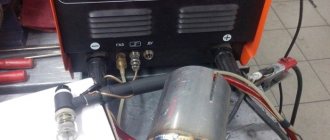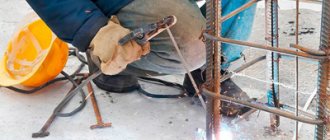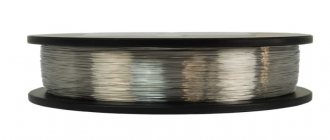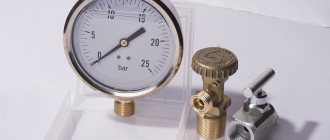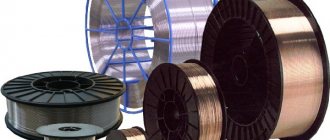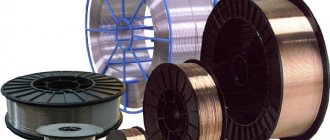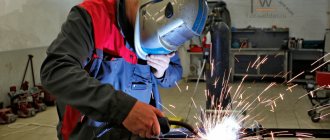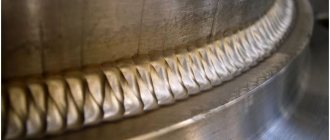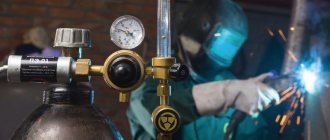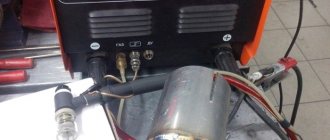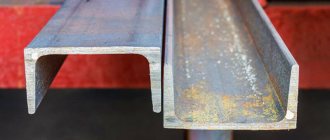What the article is about:
Who is flux-cored wire suitable for, and who should not use it?
Semi-automatic welding has a number of significant advantages. Firstly, the speed of welding work increases significantly. Secondly, there is no slag during welding. You can weld long seams without interruption. Thirdly, this is more delicate work with workpieces that are very thin.
The only thing needed for semi-automatic welding is shielding gas. But what if there is no protective gas? How to cook semi-automatically without gas? In fact, there is a way out, and its name is “cored wire”.
Flux-cored self-shielding wire independently takes on the task of protecting the weld pool. That is, if in the usual case, when welding with a semi-automatic machine, gas is needed for this, then, without using it, you can weld with only flux-cored wire.
Features of the method
The connection of metal parts using semi-automatic welding occurs as a result of the continuous supply of a fusible electrode. A hollow tube of a certain diameter acts as an electrode. Melting occurs from an electric arc.
In industry, there are two ways of operating a semi-automatic machine:
- the use of a gas environment is necessary subject to the requirement of protecting the seam from oxygen;
- welding without gas frees the welder from the difficulties associated with moving equipment, as well as constantly replenishing the container.
In order to avoid labor costs, it is recommended to use semi-automatic welding without a gas environment. A flexible tube is used; the material has a cavity inside; during the manufacturing process, the void is filled with flux, it is heated, and gas is released. The seam is protected from the action of foreign substances. The benefits include:
- powering the device from the central network using wires;
- mobility of the device;
- continuous supply without stopping to replace the electrode.
Special properties of aluminum
The widespread use of aluminum is explained by its low specific gravity, fairly stable strength and corrosion resistance. But its behavior during heat treatment creates difficulties when connecting aluminum structures and parts by welding. This is explained by the specific physical and chemical properties of aluminum:
- it does not change its color when heated strongly, so it is difficult to understand from the color the degree of heating of the metal;
- has a wide melting temperature range, unlike steel alloys, and begins to melt at a low temperature threshold, losing its strength;
- does not show a tendency to magnetization;
- has high thermal conductivity (on average 5 times more than steel alloys), therefore, when the joint zone is heated, heat intensively spreads throughout the entire part being welded. In order not to lose it, before carrying out welding work, especially large aluminum products, they are pre-heated;
Due to the active interaction of aluminum with oxygen in the air, an oxide film is formed on its surface. Once a certain thickness is reached, it then begins to protect the aluminum from further oxidation. At the same time, the oxide film creates difficulties during welding, because it melts at a temperature of 2050-2200°C, in contrast to the metal itself, which has a melting point in the region of 660°C.
Wire selection
For welding without gas, flux-cored wire is required. It is a hollow metal tube filled with special flux and steel chips. It is installed in a special mechanism for uniform feeding. The welding wire is selected according to the material to be joined.
Advantages and disadvantages of cored wire
Advantages:
- flux-cored wire welding does not require an additional gas environment;
- the ability to move equipment to any location;
- performing work in hard-to-reach places;
- high speed method of joining metal parts.
Flaws:
- high cost of consumables;
- The quality of the seam is worse compared to the gas method.
Refueling and consumption
To weld with wire, you must do the following:
- Rollers of a certain diameter are installed on the device;
- It is not recommended to tighten the clamping mechanism with force;
- the tip on the welding head is removed;
- when the end of the material appears on the head, the tip is put on again;
- To protect against splashes of molten metal, it is necessary to carry out treatment.
The flux material is selected depending on the metal being welded. In this case, the flow rate is regulated on a semi-automatic device and depends on the magnitude of the electric current.
Best Copper Coated Welding Wire
This type of welding wire is used for welding carbon and structural steels. The interior is made of plain metal, while the outer coating is enriched with copper, which reduces spatter and delays the formation of hot cracks. This is also suitable for welding cast iron.
The wire has increased tensile strength and is perfect for use in the garage, country house and production where welding of “black iron” is required.
| SV-08G2S-O (0.8 mm; coil 5 kg) Cedar | OK Autrod 12.51 (0.8 mm; 5 kg) ESAB | |||||||
| Weight, kg | 5 | 5 | ||||||
| Diameter, mm | 0,8 | 0,8 | ||||||
| Eurocoil | D200 | D200 | ||||||
| Homeland of the brand | Russia | Sweden | ||||||
SV-08G2S-O (0.8 mm; coil 5 kg) Cedar
Domestic product for welding in inert gases. The convenient reel can be easily installed into the drum. A 5 kg spool of filler material lasts a long time.
+ Pros SV-08G2S-O (0.8 mm; coil 5 kg) Cedar
- Suitable for all carbon and low alloy steels. The seam is really smooth and clean due to the absence of splashes.
- This results in deep penetration.
— Cons SV-08G2S-O (0.8 mm; coil 5 kg) Cedar
- It is not suitable for all semi-automatic machines due to the attachment to the drum (a Euro-reel is used).
- Not suitable for working in an environment of active gases (carbon dioxide) - you need to be careful when choosing for welding car bodies and thin metals for ventilation.
Conclusion. This is the best welding wire for semi-automatic machines in cases where maximum purity of the metal after welding is important. It is characterized by a minimal amount of splashes, due to which the adjacent thread or front surface will remain undamaged.
OK Autrod 12.51 (0.8 mm; 5 kg) ESAB
A Swedish product from a famous brand, manufactured at production facilities in the Czech Republic. It is produced in rolls weighing 5 kg and complies with GOST SV-08G2S-O.
+ Pros OK Autrod 12.51 (0.8 mm; 5 kg) ESAB
- The seam retains good impact strength even when the temperature drops to -20 degrees - in this case the figure will be 90 J/cm2.
- Smooth, good seam without sagging.
- Soft burning of the welding arc.
— Cons OK Autrod 12.51 (0.8 mm; 5 kg) ESAB
- Not very even installation, despite the branded manufacturer - slipping in the channel is possible.
- The design of the reel may differ from the photo in online stores.
- The wire is stiff and difficult to thread into the feed mechanism.
Conclusion. Good wire, suitable for sealing cracks in the frames of various equipment and mechanisms. It has a tensile strength of 560 MPa, so it is resistant to stretching during impacts. Seams made semi-automatically with this wire have increased strength.
Necessary equipment and types of wire
For connection without gas, any device with the ability to switch reverse polarity to direct polarity can be suitable. When using wire with flux, select a semi-automatic welding machine without gas. In this case, it is necessary to connect the terminals of the equipment, as when working with electrodes. The result will be increased arc output energy, as well as temperature at the weld.
Initially, the feeding mechanism is debugged. The resulting distortions can damage the material and reduce the quality of the connection. When choosing equipment, consider:
- small size for quick movement;
- smooth adjustment of the electric arc;
- use of various materials.
The following types of wire are distinguished:
- with flux core;
- with metal powder core.
Wire for semi-automatic machine
Equipment setup
The selected parameters will help you connect metal parts with a high-quality seam. Pre-requisite:
- determine the amount of electric current to be supplied to the equipment terminals;
- configure the inverter welding machine according to the specified parameters;
- install a set of gears on the feed mechanism;
- make a test seam on a piece of metal;
- After making sure that the parameters are set correctly, perform a metal connection.
Manufacturers of welding wire products
The main brands of welding wire are produced by the following manufacturers:
- SvarMontazhStroy. One of the most famous Russian production facilities, specializing in the production of filler wire of various brands for all types of welding. Modern equipment and the use of European manufacturing technologies allow the company to produce products that meet the highest quality standards.
- LLC Petromet. The enterprise, which belongs to the Leningrad plant, produces wire grades Sv01Х18Н10, Sv-15ХМА and others.
- Weld-Metiz LLC.
- OJSC Volgograd Steel Wire Rope Plant. Stainless steel wire produced by the steel wire rope plant meets state standards and can be used when performing welding work with a semi-automatic device.
- OJSC West Siberian Metallurgical Plant.
Table of types of welding wire.
Filler materials for semiautomatic welding machines produced by these enterprises are divided into 77 varieties. Many manufacturers coat the welding filler wire with copper, which produces a better weld and reduces molten metal droplet spatter.
How to cook semi-automatically without gas
Semi-automatic welding without gas using regular flux wire is performed according to the following algorithm:
- metal parts must be pre-prepared; to do this, clean the joint and degrease the edges;
- on the mechanism with wire, a low feed speed is set, as well as minimum voltage values;
- It is recommended to run the torch at an angle forward, the arc is intermittent;
- the equipment is set to the correct polarity for welding with flux-cored wire without gas;
- the movement rollers and the tip on the head are selected according to the diameter of the filler material;
- the end is treated to prevent the adhesion of metal splashes;
- the welding movement begins from the top of the seam, evenly without jerking;
- flux cored wire is fed to the leading edge;
- For novice welders, it is recommended to initially perform a test weld.
Joining metal by welding is a complex technological process that requires compliance with the necessary safety measures, as well as the availability of protective equipment.
Best Aluminum Welding Wire
Used for making seams on structures made of aluminum and its alloys. This is a highly specialized type of welding, which is in demand in car services, the food industry, the chemical industry and in the repair of water transport. This type of additive is not suitable for joining other types of metals, and welding with its use requires some skill.
ER 5356 (ALMG5)
Aluminum wire with in-line winding. Sold in weights from 500 g to 7 kg. Suitable for semi-automatic welding of aluminum plates, pipes and profiles with a magnesium content of less than 3%.
+ Pros of ER 5356 (ALMG5)
- Good preservation of the reel during transportation thanks to the film cover and cardboard packaging.
- The seam is completely free of pores.
- Suitable not only for butt joints in the lower position, but also for corner joints on both the inside and outside.
- There are no undercuts on the top wall with a fillet weld.
— Cons of ER 5356 (ALMG5)
- High-quality welding is possible only with direct current.
- The seam is high and has rough scales.
- The tensile strength of 265 MPa is not the highest in the category.
- You need to set the feed speed to high - it melts quickly.
- After welding there is a strong black coating.
- Suitable for long seams, since on short ones it does not allow the metal to heat up properly and only lies on top.
Conclusion. Excellent aluminum wire for welding cylinder heads or crankcase covers, which will be useful in the auto repair shop. It has an elongation of 26%, which promotes good transfer of thermal expansion.
How to choose the right material
To properly weld the required parts or correct a defect, you need to use the appropriate welding wire.
- If it is necessary to connect parts with a low carbon content in steel, it is recommended to use wire with a low carbon content.
- It can be recognized by its marking; it will have the numbers 080. It may also contain silicon.
- Structures made of such material must be welded using wire, using a semi-automatic machine for these purposes without the use of gas.
For welding stainless or alloy steel, it is also necessary to pay great attention to the consumable markings. If the wrong material is used, the quality of the weld will be significantly worse, which in turn creates the possibility of weld failure.
Welding of aluminum parts can only take place in a protective atmosphere of Argon. Therefore, it is necessary to use a solid material with a solid cross-section.
Please note that it is recommended to use aluminum wire for semi-automatic machines immediately after opening the protective packaging. This is due to the fact that during long-term storage, oxidation appears on such wire due to contact with atmospheric oxygen.
Copper, as well as aluminum, must be welded in Argon, or any other suitable gas must be used for this. In this case, the wire is divided into several types according to its purpose.
- For welding pure copper parts or low-alloyed ones
- For welding bronze and other low-alloy alloys based on this metal
- For creating welded joints of rolled and cast copper
It often happens that you need to connect two different types of metal by welding; for this purpose you need to use a surfacing wire, it has the designation “NP”.
Device characteristics
In order to choose the right semi-automatic welding machine for working without carbon dioxide, the following nuances should be taken into account:
- the device must be light and small-sized so that there is no need for a gas cylinder;
- the device must be affordable;
- the inverter device must have ample opportunities to configure the parameters of the electric arc;
- the unit must allow the use of different types of welding materials.
When choosing a welding technology, it is also necessary to take into account the fact that carbon dioxide is heavier than air and sinks downward. Therefore, the method is unsuitable for working in the upper position and with large slopes of inclined seams : the weld pool will not be sufficiently protected. Only the most qualified and experienced welders will be able to weld ceiling seams using flux-cored wire; it is too difficult for beginners.
What models to pay attention to
Models are presented in two types:
- rectifier;
- inverter
Rectifier
It consists of a power transformer and a block of diodes that generate a unidirectional pulsating current. Equipped with a wire feed mechanism. They work in several modes:
- MIG/MAG - solid wire is used.
- Activated wire is used - a composite material made from a layer of protective flux, base metal and alloying additives.
- A powder electrode is a hollow tubular structure with flux inside.
- Spot resistance welding (for professional models).
Most of the models produced belong to the semi- and professional class. Wire welders used in everyday life or small workshops have:
- power up to 10 kW;
- maximum welding current up to 250 A;
- open circuit voltage 15-45 V;
- weighing 25-35 kg.
Model SPECIAL MAG-172. Semi-automatic, used for welding in the “with/without gas” mode. Connects ferrous and stainless steel, non-ferrous metals (aluminium, copper) and alloys based on them.
Model ENKOR-140 MIG 56731. Device for working with low-carbon or stainless steel. Used with inert or active gas. It is possible to use a powder flexible electrode.
| Characteristics | SPEC MAG-172 | ENKOR-140 MIG 56731 |
| Power | up to 6.3 kWt | up to 5.5 kWt |
| Current | up to 250 A | up to 140 A |
| PV at maximum mode | no more than 10% | no more than 10% |
| Assembled weight | up to 35.5 kg | up to 28 kg |
Inverter
The source of arc creation is an inverter. Consists of primary and secondary rectifiers, high-frequency transformer, control unit. Settings are automated. They are small in size and have the following functions:
- Manual arc welding with all electrodes.
- Connecting parts using inert or active gas with automatic supply of a flexible electrode.
- Use of powder electrode or activated wire.
- Non-consumable electrode operation with or without gas.
Models of all classes are produced: household, semi- and professional. Convenient for beginner welders. This is explained:
- ease of use;
- stable electric arc characteristics;
- resistance to changes in voltage parameters in a stationary power supply network.
Model Resanta SAIPA 135. Semi-automatic device used for joining workpieces made of ferrous and stainless steels, non-ferrous metals. It is used for welding with and without gas, as well as with flux-cored wire.
Model Svarog REAL MIG 200. Semi-automatic for working in MMA, MIG/MAG modes and powder electrodes. Connects low-carbon and stainless steel, aluminum alloys. Mains voltage 220 V.
| Characteristics | SAIPA 135 | SVAROG REAL MIG 200 |
| Power | up to 6.6 kWt | up to 5.4 kWt |
| Current | up to 110 A | up to 200A |
| PV at maximum mode | no more than 70% | no more than 60% |
| Assembled weight | 11 kg | 13 kg |
